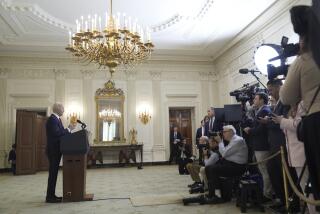Detroit Newspapers, City Ready for Battle : Hearings to Begin on Papers’ Controversial Proposed Joint Agreement
- Share via
On one side will stand the city of Detroit, represented by the mayor and five labor unions.
On the other will be two of the nation’s most powerful newspaper chains, Gannett Co. of Washington and Knight-Ridder Newspapers of Miami.
They begin today a strange civic opera on the health of Detroit: long-awaited public hearings on the plan to merge the business operations of the city’s two rival newspapers.
During the next few weeks, both sides will testify before a Justice Department administrative law judge about whether Detroit can support two independent newspapers, and in the process say much about the state of American newspapers, the conduct of two giant newspaper companies and the future of Detroit.
Since before the turn of the century, the Free Press, now owned by Knight-Ridder, and the Detroit News, now owned by Gannett, have waged one of the nation’s last knives-and-chains newspaper rumbles. To this day, they raid each other’s news staffs, snipe back and forth in editorials and feud in their ad campaigns. In Detroit, one can still buy a daily newspaper (the News) for 15 cents.
Intense Rivalry
The rivalry was such that after employing a tank from Chrysler to cover the 1967 race riots--the cannon was missing--the Free Press staff drove the armored combat vehicle the two blocks to the News and demanded in jest that it surrender.
Generally, analysts call the brawl a draw, with the News enjoying an edge in circulation and roughly 60% of ad revenues, but the Free Press dominating the gradually growing morning market. Both papers, according to documents filed with Justice, have recently lost money.
But in 1986, racked by dissent, the family that owned the News sold to Gannett for about $150 million. Within weeks, the two papers unveiled a truce plan. They would combine business operations and share profits but maintain separate news staffs. The Free Press would take the mornings. The News would publish afternoons.
Such a merger, technically known as a joint operating agreement, is allowed to newspapers under a special exemption to the U.S. antitrust laws. But to qualify, one of the newspapers--in this case, the Detroit Free Press--must prove that it is failing and would otherwise die.
Following the hearing, Administrative Law Judge Morton Needelman will rule on the JOA proposal. But the ultimate decision rests with Atty. Gen. Edwin Meese, and no attorney general has ever turned down such an agreement.
One reason, analysts have said, is that by the time the approval process is finished, the failure of the paper representing itself as imperiled becomes a self-fulfilling prophecy.
Already, said some staff members privately, morale at the Free Press is suffering. Free Press Publisher Dave Lawrence does not go so far, but he does concede: “It has been tougher on the Free Press in the last 16 months than the News.”
The hearings on the matter, which are expected to last a month, will focus on seven key questions raised by the Justice Department.
Several of these concern whether the Free Press, as an alternative to merging, could find a profitable niche as a No. 2 paper. The answer, revealed in written testimony already made public, says much about the way American newspapers operate.
Gannett Chairman Allen H. Neuharth and Knight-Ridder Chairman Alvah H. Chapman Jr. will argue, according to their written testimony, that metropolitan newspapers can only survive when they have an economic monopoly.
It is, wrote Neuharth, “an economic fact of life in the newspaper business: The dominant newspaper ultimately thrives; the weaker newspaper ultimately dies.”
‘Operation Tiger’
Accordingly, the morning Free Press never tried to be a profitable No. 2 newspaper. Instead, it launched in 1984 an expensive internal strategy for total victory, called “Operation Tiger,” designed to make the Free Press the dominant newspaper and drive the No. 1 News into submission.
The News responded similarly, agreeing to forgo profit now to fund a battle to the death.
Detroit Mayor Coleman Young and the newspaper unions will argue, according to their written testimony, that the papers’ losses are due to this conviction that they had to dominate or die. They didn’t make a profit because they didn’t try.
For instance, the fact that the News charges only 15 cents and the Free Press 20 cents for their weekday editions, both below the industry average of 25 cents, is “another sign that they weren’t making a good-faith effort to make a profit,” Young said in an interview last week.
According to figures from the American Newspaper Publishers Assn., only 25 cities today have newspapers that compete financially, and in only one of those cities--San Antonio--can both papers be said to be prospering, according to John Morton, a newspaper industry analyst who will testify for the newspapers. Even in New York, the nation’s largest city, only the New York Times is profitable, while the New York Daily News and New York Post are posting losses.
Effect of Television
In the meantime, 21 cities have newspapers that compete for news but share business operations under joint operating agreements such as the one sought in Detroit.
The reason, say newspaper analysts, is that television has drained advertising dollars to the point that only one paper can thrive per city, even in the largest cities, such as New York.
Based on their pre-hearing written testimony, witnesses opposing the JOA will argue that Detroit may be different. Most cities where newspapers have failed are smaller. And rarely have two papers been so close in circulation and advertising when they applied for a JOA.
Michigan bond expert Chester Johnson is also expected to argue that Detroit’s economy is in “re-growth” and already is as healthy as in 1978-79, when both Detroit papers made money.
The other key issue in the hearings concerns the losses claimed by the two papers in their JOA application. Are they believable?
The News, for instance, claimed to lose more than $13 million in 1986, after proposing the JOA. In 1985, the year before the JOA proposal, it posted an operating profit of $667,000.
Accounting Change Cited
Why did their fortunes get suddenly worse after the JOA proposal? Peter B. Clark, former chairman of the News before the sale to Gannett, is expected to testify that the company used a variety of accepted accounting methods to show a small operating profit in 1985 to assuage angry shareholders, who eventually forced the sale of the company anyway. Using different accounting, the paper could have reported a loss of $4.4 million, Clark now claims.
The Justice Department also has raised questions about whether the Free Press employed “creative bookkeeping” to inflate its losses. The Free Press has reported losing $22 million since 1986.
Assistant Atty. Gen. Douglas Ginsberg, for instance, has argued that Knight-Ridder might have inflated expenses in the way it accounted for the costs of Operation Tiger. Ginsberg has also suggested that Knight-Ridder is overcharging the Free Press for management fees and interest charges.
The newspaper’s officials are expected to defend its accounting practices and to explain that the fees are a legitimate way of paying back Knight-Ridder for the many benefits it accrued from being owned by a large chain.
Were the Free Press a stand-alone paper, wrote Free Press General Manager Robert Hall in his written testimony, it would have long ago run out of cash and today probably could not get the loans needed to stay alive.
The issue of whether the Free Press is failing is complicated, also, because many analysts before the JOA proposal expected the Free Press, not the News, to ultimately win the newspaper war. The Free Press, after all, dominated the growing morning market. Matters changed when the wealthy Gannett Co. bought the News.
But even under the JOA proposal, opponents are expected to argue, an internal report by the newspapers projected that the Free Press would eventually become the dominant paper in weekday circulation. Under the JOA, the News will be relegated to the afternoon and produce most of the Sunday paper.
Questions Raised
Mayor Young also is expected to question the Free Press’ claims of failure by arguing that when the paper applied for andwon a 12-year, 50% tax break for its $23-million riverfront printing plant in 1985, the company said nothing about financial problems or having any doubt about its future.
With the loss of financial competition, Mayor Young is worried that the city could lose editorial variety. The News, which Young argued has been “suspect regarding their fair and accurate appraisal of racial matters” in editorials, would dominate the board running the two papers after the JOA.
Officials at both papers have dismissed the Mayor’s claim, vowing to maintain editorial independence, and since the announcement of the JOA, in fact, the News has raided Free Press news staff.
10 Biggest Newspaper Joint Operating Agreements M - Morning E - Evening
Year Year of City/ Agreements Renewal or Newspaper Circulation Began Expiration San Francisco Chronicle (m) 557,934 Examiner (e) 142,335 1965 1995 Miami Herald (m) 437,233 News (e) 56,590 1966 1996 Pittsburgh Post-Gazette (m) 157,982 Press (e) 232,881 1961 1999 Seattle Post-Intelligencer (m) 203,726 Times (e) 231,726 1983 2032 Cincinnati Enquirer (m) 191,645 Post (e) 115,718 1979 2007 Birmingham (Ala.) Post-Herald (m) 62,318 News (e) N.A. 1950 2001 Tulsa World (m) 127,857 Tribune (e) 72,106 1941 1996 Nashville The Tennessean (m) 122,589 Banner (e) 67,408 1937 1997 Salt Lake City Tribune (m) 112,625 Deseret News (e) 63,204 1952 2012 Honolulu Advertiser (m) 88,963 Star-Bulletin (e) 109,332 1962 2042
Source: American Newspaper Publishers Assn.
Circulation figures: Audit Bureau of Circulation as of 3/31/87 . Circulation is for weekdays only .
More to Read
Sign up for Essential California
The most important California stories and recommendations in your inbox every morning.
You may occasionally receive promotional content from the Los Angeles Times.













